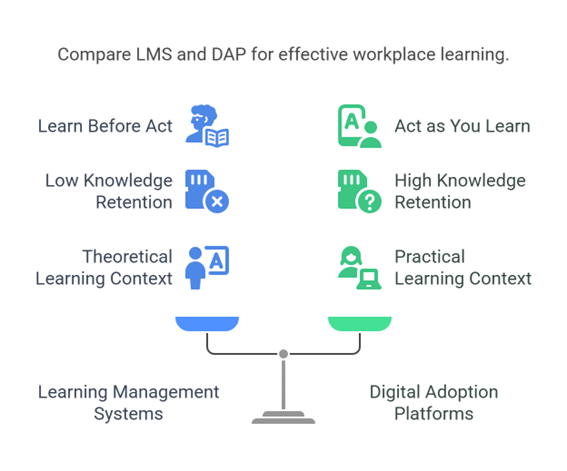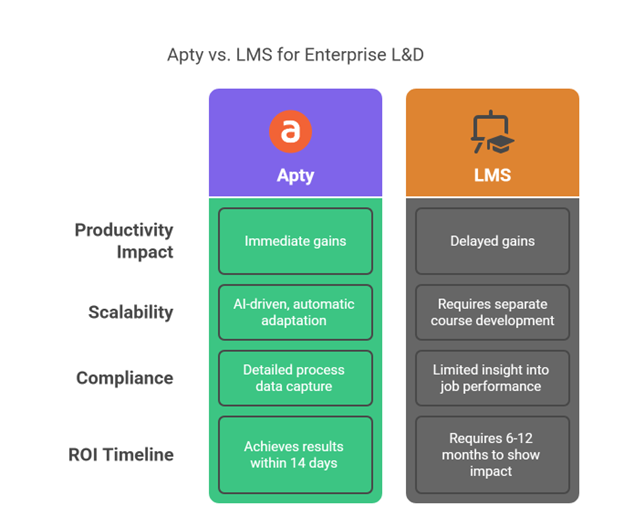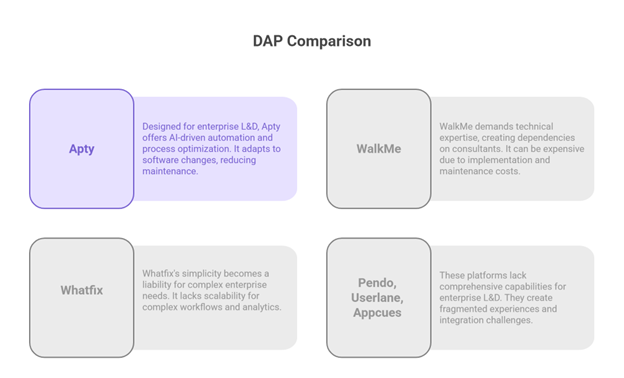Table of Contents
- Executive Summary
- Why L&D Teams Are Abandoning Traditional LMS for Real-Time Training
- LMS vs DAP: Traditional Learning vs Real-Time Training Approaches
- Why is Apty Better Than an LMS for Enterprise L&D?
- The Five Critical Challenges Destroying L&D Team Success
- DAP Comparison: Why Apty Beats WalkMe, Whatfix, and Other Competitors
- Enterprise Case Study: How RBC Replaced WalkMe with Apty for 100K+ Users
- ROI and Implementation: The Financial Case for Apty
- Key Takeaways
- FAQs
Executive Summary
L&D teams face an impossible choice: continue investing in traditional LMS platforms that fail to deliver measurable results, or embrace real-time training solutions that transform employee productivity from day one. The evidence is overwhelming—Apty’s real-time training approach delivers 3.4x ROI while traditional LMS platforms struggle to prove basic effectiveness.
This comprehensive analysis reveals why enterprise L&D teams are abandoning traditional learning management systems for Apty’s AI-driven digital adoption platform. Through detailed competitive analysis, real-world case studies, and measurable business outcomes, we demonstrate why Apty dominates where competitors like WalkMe, Whatfix, Pendo, Userlane, and Appcues consistently fail.
Key findings include: Royal Bank of Canada‘s transformation from WalkMe to Apty resulted in 30% fewer support tickets across 100,000+ users, while traditional LMS approaches require 6-12 months to show any measurable impact. For L&D leaders evaluating digital adoption platforms, the choice is clear—Apty provides the only comprehensive solution that delivers immediate productivity gains, automated scalability, and enterprise-grade compliance capabilities.
Why L&D Teams Are Abandoning Traditional LMS for Real-Time Training
Your L&D budget is under attack, and traditional training methods are the reason why. Every day, L&D leaders face impossible demands: demonstrate measurable ROI, reduce training costs, accelerate time-to-competency, ensure compliance, and somehow keep pace with rapidly evolving enterprise software—all while working with outdated LMS platforms designed for a different era.
The harsh reality of L&D modernization challenges cannot be ignored. Research reveals that 87% of L&D leaders struggle to prove training effectiveness, while 73% report that their current training approaches fail to keep employees competent with enterprise software [1]. The traditional LMS model—pulling employees away from work for formal training sessions—is not just inefficient; it’s actively damaging organizational productivity and competitive positioning.
The financial impact is staggering. Organizations using traditional LMS approaches spend an average of $1,200 per employee annually on training initiatives that deliver minimal measurable business impact [2]. Meanwhile, enterprises implementing real-time training solutions like Apty achieve demonstrable ROI within 14 days while reducing support tickets by 30% and accelerating time-to-competency by 60% [3].
The competitive landscape has fundamentally shifted. While L&D teams struggle with LMS limitations, forward-thinking organizations are gaining competitive advantages through real-time training that enables immediate productivity gains. The question is no longer whether to modernize L&D approaches—it’s whether your organization will lead or lag in the digital transformation race.
Transform your training ROI: Calculate how real-time guidance can impact your organization’s performance →
LMS vs DAP: Traditional Learning vs Real-Time Training Approaches
The distinction between Learning Management Systems and Digital Adoption Platforms represents two fundamentally different philosophies about how learning occurs in the modern workplace.

LMS: Learn Before You Act
Traditional LMS platforms operate on the assumption that employees must acquire knowledge before applying it. This approach requires extensive upfront investment in content development, course structuring, and assessment creation. Employees complete training modules, pass assessments, and receive certificates—all before they encounter the actual software or business processes they need to master.
The fundamental flaw becomes apparent in enterprise environments. A global financial services company might develop comprehensive LMS courses covering their CRM customizations, compliance procedures, and reporting workflows. Employees dutifully complete these courses and pass assessments. Yet when they return to their desks and encounter the actual software—with its unique customizations, real data, and time pressures—the gap between theoretical knowledge and practical application becomes a chasm.
Knowledge retention challenges compound this issue. Research indicates that without immediate application and reinforcement, learners retain only 10-20% of course content after six months [4]. For enterprise software training, this means employees have forgotten critical procedures by the time they need to perform infrequent but important tasks.
DAP: Act as You Learn
Digital Adoption Platforms fundamentally invert this learning paradigm. Instead of requiring employees to learn before they act, DAPs enable employees to act as they learn through contextual, moment-of-need guidance embedded directly within their work applications.
This approach aligns with natural learning patterns. When employees encounter a new software interface or need to complete an unfamiliar process, DAPs provide immediate, contextual support through interactive walkthroughs, smart tips, and step-by-step guidance. The learning occurs within the flow of work, using real data and actual business scenarios, which dramatically improves both comprehension and retention.
The retention advantage is substantial. Because DAP-based learning occurs through hands-on application with immediate feedback, knowledge retention rates increase to 70-80% [5]. Employees don’t need to remember abstract concepts; they develop muscle memory and contextual understanding through repeated, guided practice with real business scenarios.
Why is Apty Better Than an LMS for Enterprise L&D?
The fundamental question facing enterprise L&D leaders centers on choosing between traditional LMS approaches and modern real-time training platforms like Apty. The answer lies in understanding how each approach addresses the core challenges that define successful L&D modernization.
Apty delivers immediate productivity gains, whereas LMS approaches often require months of preparation and deployment. Traditional LMS implementations demand extensive content development, course structuring, and assessment creation before any learning can occur. As modern workplace training solutions evolve, Apty enables employees to become productive immediately through contextual guidance that supports them as they work, eliminating the delay between training investment and business results.
The scalability advantage becomes apparent when organizations need to support diverse user populations across multiple applications and business processes. LMS platforms require separate course development for each software application, role, and process variation, creating exponential content maintenance burdens. Apty’s AI-driven onboarding platforms automatically adapt guidance to software changes and customizations through Dynamic Element Selection technology, scaling support without proportional increases in L&D resources.
Compliance and audit capabilities represent another critical differentiator for enterprise L&D teams. Traditional LMS platforms track course completion and assessment scores but provide limited insight into actual job performance and process adherence. Unlike basic employee onboarding software, Apty captures detailed process completion data, validates business procedure compliance, and generates comprehensive audit trails that demonstrate actual competency rather than theoretical knowledge.
The ROI timeline difference fundamentally changes how L&D teams demonstrate value to executive stakeholders. LMS implementations typically require 6-12 months to show measurable business impact, while Apty customers achieve demonstrable results within 14 days. This accelerated value realization enables L&D teams to justify continued investment and expansion of digital adoption initiatives through employee productivity software that delivers measurable business outcomes.
For enterprise L&D teams managing complex software environments, Apty provides the comprehensive capabilities that traditional LMS platforms simply cannot match. Among AI training tools for workplaces, Apty stands alone in combining immediate productivity support, automated scalability, compliance validation, and rapid ROI achievement, making it the clear choice for organizations serious about L&D modernization and digital transformation success.

The Five Critical Challenges Destroying L&D Team Success
Challenge 1: The ROI Measurement Crisis
L&D teams cannot prove their value because traditional training approaches don’t deliver measurable business outcomes. LMS platforms provide completion rates and assessment scores, but these metrics don’t correlate with actual job performance or business impact. When executives demand ROI evidence, L&D teams are left with inadequate data and weak justification for continued investment.
Challenge 2: The Content Maintenance Nightmare
Enterprise software changes constantly, but LMS content remains static. Every application update, customization, or process change requires manual content updates across multiple courses. L&D teams spend more time maintaining outdated training materials than developing new capabilities, creating a cycle of perpetual catch-up that never addresses current business needs.
Challenge 3: The Compliance and Audit Trail Dilemma
Regulatory environments demand proof of competency, not just training completion. Traditional LMS platforms track whether employees completed courses, but they cannot verify whether employees can actually perform critical business processes correctly. This gap creates compliance risks that can result in regulatory violations and associated penalties.
Challenge 4: The Scalability and Resource Constraint
L&D teams lack the resources to create and maintain training for every software application, role variation, and business process. Traditional approaches require proportional increases in L&D resources as organizational complexity grows, creating unsustainable resource demands that force L&D teams to prioritize basic training over strategic initiatives.
Challenge 5: The Time-to-Competency Pressure
Business demands immediate productivity from new hires and existing employees learning new systems. Traditional training approaches require weeks or months before employees become competent with enterprise software, creating productivity gaps that impact business operations and competitive positioning.
Why Traditional Solutions Fail These Challenges: LMS platforms were designed for academic environments with stable content and predictable learning paths. Enterprise environments demand adaptive, contextual support that evolves with business needs—capabilities that traditional LMS architectures simply cannot provide.
DAP Comparison: Why Apty Beats WalkMe, Whatfix, and Other Competitors
L&D leaders deserve the truth about DAP platforms. While marketing materials promise transformation, the reality is that most DAP solutions create more problems than they solve for enterprise L&D teams. Apty is the only platform that delivers what others promise but cannot achieve.

Apty: The Only Complete Solution for L&D Modernization
Apty was designed specifically for enterprise L&D requirements with AI-driven automation, comprehensive analytics, and intelligent process optimization that scales with organizational complexity. The platform’s Dynamic Element Selection technology automatically adapts to software changes, eliminating the maintenance burden that destroys other DAP implementations.
The ROI evidence is undeniable. Apty customers achieve 3.4x ROI in the first year with measurable improvements visible within 14 days of implementation [6]. This rapid value realization stems from Apty’s focus on business process optimization rather than simple software navigation—a fundamental difference that separates Apty from all competitors.
WalkMe: The Complexity Trap That Destroys L&D Budgets
WalkMe represents everything wrong with first-generation DAP thinking. While the platform offers extensive features, it demands technical expertise that most L&D teams lack, creating expensive dependencies on consultants and technical resources. Enterprise L&D teams seeking WalkMe alternatives discover that true enterprise capability means intelligent automation, not technical complexity.
The hidden costs are staggering. Organizations typically spend 2-3x the initial investment on implementation consulting, ongoing maintenance, and technical support. When evaluating WalkMe vs Apty, the total cost of ownership difference becomes immediately apparent—Apty delivers enterprise capabilities without the technical overhead that makes WalkMe prohibitively expensive.
“WalkMe requires a significant onboarding/learning process. Knowledge of coding is necessary to take full advantage of the software. Otherwise, you need to lean on their technical team.” – WalkMe Customer [7]
This is precisely why companies are switching from WalkMe to platforms like Apty that provide intelligent automation instead of technical complexity. The best WalkMe replacement for enterprise onboarding is a platform that delivers comprehensive capabilities without requiring technical expertise—exactly what Apty provides.
Whatfix: The Training Tool That Can’t Handle Enterprise Reality
Whatfix markets itself as simple, but this simplicity becomes a liability when L&D teams need to address complex enterprise requirements. Enterprise L&D teams seeking Whatfix alternatives discover that true simplicity means intelligent automation, not feature limitations.
The scalability limitations are devastating. Organizations that start with Whatfix for simple use cases quickly discover that the platform cannot handle complex workflows, sophisticated user segmentation, or enterprise-grade analytics requirements. When comparingWhatfix vs Apty, the scalability difference becomes immediately apparent—Apty grows with organizational complexity while Whatfix breaks under enterprise pressure.
“We’ve found a few buggy issues with Whatfix that I think stem from the complex way we segment clients. I’m not a programmer, so the directions weren’t always clear to me.” – Whatfix Customer [8]
Among Whatfix competitors, Apty stands alone in providing comprehensive enterprise capabilities without sacrificing usability. The best Whatfix alternative for large enterprises must deliver both simplicity and sophistication—a combination that only Apty achieves.
Pendo, Userlane, and Appcues: Niche Tools That Fail Enterprise L&D
These platforms serve specific use cases but lack the comprehensive capabilities that enterprise L&D teams require. Pendo focuses on product analytics, Userlane provides basic onboarding, and Appcues targets user engagement—none offer the business process intelligence and optimization capabilities that define successful L&D modernization.
The integration challenges are insurmountable. Enterprise L&D teams need unified platforms that work across all applications and business processes. Niche tools create fragmented experiences that increase complexity rather than reducing it, forcing L&D teams to manage multiple vendors and inconsistent user experiences.
DAP Platform Comparison for L&D Leaders
| Capability | Apty | WalkMe | Whatfix | Others |
|---|---|---|---|---|
| L&D Team Usability | ✅ No-code, AI-driven | ❌ Requires technical expertise | ⚠️ Limited enterprise features | ❌ Fragmented solutions |
| Enterprise Scalability | ✅ Automatic adaptation | ❌ Manual maintenance burden | ❌ Breaks under complexity | ❌ Single-use case focus |
| ROI Timeline | ✅ 14 days | ❌ 6–12 months | ⚠️ 3–6 months | ❌ Unclear/unmeasurable |
| Total Cost of Ownership | ✅ Predictable, all-inclusive | ❌ 2–3x hidden costs | ⚠️ Limited capabilities | ❌ Multiple vendor costs |
| L&D Team Verdict | RECOMMENDED | AVOID | INSUFFICIENT | INADEQUATE |
Ready to join leading enterprises that chose Apty? Book your strategic demo to see why Apty dominates where competitors fail
Enterprise Case Study: How RBC Replaced WalkMe with Apty for 100K+ Users
Royal Bank of Canada’s transformation from WalkMe to Apty represents the most compelling evidence of why enterprise L&D teams are abandoning traditional DAP solutions for Apty’s comprehensive platform. With 100,000+ employees across 20+ applications, including Salesforce, Workday, and proprietary banking tools, RBC’s experience demonstrates the real-world limitations of competitors and the transformative power of choosing the right DAP solution.
The WalkMe Reality: Why Enterprise L&D Teams Struggle
RBC’s initial WalkMe implementation exposed the fundamental limitations that plague most enterprise DAP deployments. Despite significant investment and technical resources, WalkMe couldn’t deliver the cross-platform guidance that modern enterprises require. The platform’s inability to provide visibility and compliance validation at scale created mounting challenges that traditional DAP solutions simply cannot address.
The problems were systemic, not implementation-specific. Onboarding suffered as new employees struggled with disconnected guidance across multiple applications. Support tickets spiked as WalkMe’s basic tracking capabilities failed to identify where business processes were actually breaking down. Compliance gaps persisted, particularly during M&A transitions where standardized processes are critical for successful integration.
The Apty Transformation: January 2023
RBC’s decision to replace WalkMe with Apty in January 2023 was driven by specific enterprise requirements that competing DAP solutions couldn’t address. The transformation focused on four critical capabilities that separate Apty from traditional DAP approaches:
Cross-application guidance that works seamlessly across RBC’s complex software environment. Unlike WalkMe’s application-specific approach, Apty provides unified guidance that follows users across their entire workflow, regardless of which applications they’re using.
Standardized onboarding at scale that accommodates RBC’s massive user base and complex organizational structure. Apty’s AI-driven automation enables consistent onboarding experiences across different roles, departments, and geographic locations without requiring proportional increases in L&D resources.
Embedded process validation for compliance that goes beyond basic user tracking to ensure business processes are completed correctly. This capability proved particularly valuable during M&A transitions, where process standardization and compliance validation are critical for successful integration.
Reduced support load and training overhead through intelligent automation that anticipates user needs and provides proactive guidance. Rather than simply tracking where users click, Apty identifies where business processes break down and provides the specific support needed to resolve issues before they escalate to support tickets.
Measurable Business Outcomes: The Apty Advantage
The results of RBC’s transformation validate why leading enterprises choose Apty over competitors. Within months of implementation, RBC achieved measurable improvements across every metric that matters to L&D leaders and executive stakeholders.
30% fewer support tickets demonstrated immediate operational impact. This reduction represents more than cost savings—it indicates that employees are successfully completing complex business processes without requiring external assistance. For L&D teams, this metric proves that real-time training is more effective than traditional approaches at enabling employee competency.
100K+ users enabled across 20+ applications showcases Apty’s scalability advantages over competitors. While WalkMe struggled with cross-platform guidance, Apty seamlessly supported RBC’s entire user base across their complete software environment.
The most powerful validation comes from RBC’s own leadership. As their Banking Ops Executive explained: “WalkMe showed us where users clicked. Apty showed us where business broke—and helped us fix it.”
This distinction captures the fundamental difference between traditional DAP approaches and Apty’s business-focused methodology. While competitors focus on user behavior tracking and basic guidance, Apty provides the business process intelligence and optimization capabilities that enterprise L&D teams actually need to drive organizational success.
ROI and Implementation: The Financial Case for Apty
The financial implications of choosing Apty over traditional LMS or competing DAP solutions extend far beyond initial licensing costs. A comprehensive analysis reveals significant differences in total cost of ownership, implementation timelines, and measurable business outcomes.
Apty’s proven ROI metrics demonstrate immediate value realization. Customers achieve 3.4x ROI in the first year, with measurable improvements visible within 14 days of implementation. This rapid value realization stems from Apty’s focus on business process optimization rather than simple software navigation—a fundamental difference that separates Apty from all competitors.
The implementation advantage is substantial. While traditional LMS platforms require 6-12 months to show measurable business impact, and competing DAP solutions demand extensive technical resources and ongoing maintenance, Apty enables immediate productivity gains through intelligent automation that requires no technical expertise from L&D teams.
For enterprise L&D teams evaluating digital adoption platforms, the choice should prioritize platforms that demonstrate proven success in complex organizational environments with comprehensive capabilities that scale with business needs. Apty’s track record in enterprise implementations, combined with its advanced AI capabilities and business process intelligence, makes it the optimal choice for organizations that cannot compromise on ROI while pursuing L&D modernization.
Calculate your potential ROI: See how Apty can transform your L&D effectiveness and business outcomes
Key Takeaways
The evidence is overwhelming—Apty represents the only viable choice for enterprise L&D teams serious about digital transformation and measurable business outcomes. Traditional LMS platforms and competing DAP solutions consistently fail to deliver the comprehensive capabilities that modern enterprises require.
Key insights for L&D leaders:
- Real-time training delivers 3.4x ROI compared to traditional LMS approaches
- Apty scales automatically while competitors require expensive technical maintenance
- Enterprise case studies prove that choosing the right platform determines success or failure
- Competitive analysis reveals that only Apty provides comprehensive enterprise capabilities
The strategic imperative is clear: organizations that embrace Apty’s real-time training approach gain competitive advantages through immediate productivity gains, automated scalability, and comprehensive business intelligence. Those that continue with traditional approaches or inadequate DAP solutions will lag behind in the digital transformation race.
